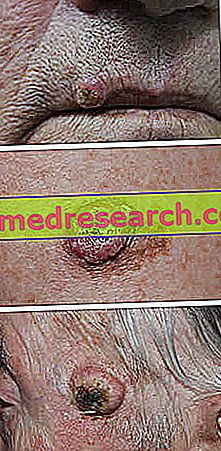Generality
Keratoacanthoma is a benign tumor of the skin, which gives rise to a solid and isolated protuberance with a very characteristic appearance.

The neoplasm originates from a hair follicle or from a pilo-sebaceous gland, develops within 6 weeks and then disappears within a few months.
There are more than one possible cause: at the origin, in fact, there may be excessive exposure to ultraviolet radiation, contact with certain toxic substances, a weak immune system (immunodepression), etc.
For a correct diagnosis, a physical examination by a dermatologist and a biopsy are required.
The therapeutic treatment adopted may be surgical or pharmacological. The choice of a specific treatment method depends exclusively on the characteristics of keratoacanthoma.
What is keratoacanthoma?
Keratoacanthoma is a benign tumor of the skin, which originates in a hair follicle or in a pilosebaceous gland . Due to its morphology and initial growth rate, it is very reminiscent of a malignant neoplasm of the skin, known as spinocellular carcinoma or squamous cell carcinoma ; however, unlike this malignant tumor, keratoacanthoma is characterized by a spontaneous resolution (after about 5-6 months) and by a potential or almost zero metastatizing potential.
NB: by metastasizing power we mean the ability of the tumor to form metastases . Metastases are cancer cells that have moved from their original location and moved elsewhere, going to first contaminate the lymph nodes and then the other organs of the body.
THE PILIFER ISSUE
The hair follicle is located in the dermis (a layer of skin between the epidermis and the hypodermis ) and it is the structure within which a hair is formed and increased.
The number of hair follicles on the skin is enormous and affects almost the entire human body; the areas that are totally free of it are the so-called glabrous regions, such as the palm of the hand, the soles of the feet, the distal phalanx of the fingers, the lips, the glans and the clitoris.
Each hair follicle corresponds to a gland that produces sebum, also called the pilosebaceous gland.

The growth of part of the body hair depends on the level of sex hormones circulating in the body: androgens, that is the male sex hormones, stimulate growth, while estrogens, or female sex hormones, have the opposite effect.
WHAT IS A BENIGNO CANCER?
In medicine, with the term tumor, a mass of very active cells is identified, able to divide and grow uncontrollably due to a genetic mutation of DNA .
In a benign tumor, in general, the growth of the cell mass is very slow, it is not infiltrative (ie it does not invade the surrounding tissues) and even metastasizing.
In other words, it is the exact opposite of a malignant tumor, which grows quickly and, if it is not removed in time from where it was formed, it can spread to the surrounding tissues and the rest of the body.
Epidemiology
According to some British estimates, keratoacanthoma has an annual incidence of one case per 1, 000 people.
It usually affects individuals over the age of 60 (in fact, juvenile cases are very rare) and is at least twice as frequent among males than among females.
In dark-skinned people (for example, Africans), it is very uncommon.
Causes
It has been shown that the formation of a keratoacanthoma can be caused by ultraviolet radiation (or UV rays ) of the sun and tanning lamps, by contact with certain toxic substances (or chemical carcinogens), by a weak immune system ( immunodepression ), by a physical trauma or pathogenic infection by a particular papilloma virus .
WHO IS MORE AT RISK?
After years of scientific and statistical studies, various conditions have been identified that favor the appearance of a keratoacanthoma. These risk factors are as follows:
- Have clear skin . Anyone can get keratoacanthoma, regardless of the complexion. However, those with less melanin, ie the skin pigment that protects the skin from harmful UV rays, is more predisposed than those who have more.
- Too much sun . Exposing yourself excessively to sunlight, especially in the central hours of the hottest days, favors the onset not only of keratoacanthoma, but also of malignant skin tumors.
- Excessive use of tanning lamps . Tanning lamps emit the same ultraviolet radiation as the sun, so overuse can have the same effects as prolonged sun exposure.
- Chronic immunodepression . An individual's immune system is its defensive barrier against infections and other threats brought by the external environment. The conditions that create a chronic weakening of the immune system (immunosuppression) favor the appearance of various disorders, including keratoacanthoma and malignant skin tumors. An emblematic case of what has just been said is represented by leukemia or lymphoma patients and organ transplants, who - being forced to suppress their immune system with special drugs - expose themselves to infectious diseases and, indeed, to malignant tumors and benign skin.
- Excessive exposure to tar and bitumen . According to some studies, bitumen and tar would contain carcinogenic chemicals capable of favoring the appearance of keratoacanthoma. In fact, among workers who treat these preparations almost every day, the incidence of this benign tumor is higher than normal.
- Infections induced by a particular strain of papilloma virus . The papilloma virus that induces the formation of warts seems to be involved, statistical data in the hand, in the onset of keratoacanthoma.
- Advanced age and male sex . The age of major onset is around 60, while the most affected sex is the male.
Comparing the spinocellular carcinoma and the keratoacanthoma, it is possible to note the remarkable similarity between the two tumors, from the etiological point of view (ie as regards the causes), although the former is malignant and the latter is benign.
Symptoms and Complications
Keratoacanthoma, in most cases, manifests itself with a cutaneous sign that resembles a volcano . In fact, on the skin, a protuberance (or papule ) appears with a small central crater filled with a particular protein of epidermis cells, called keratin .
The areas most commonly affected are the areas of skin most exposed to the sun, therefore: face, scalp, back of hands, ears, neck and legs (in women in particular).
The shape of the protuberance is roundish, the consistency is rigid and the color is identical to that of the skin or tending to red.
The dimensions may vary, depending on the patient in question, from a minimum of one centimeter to a maximum of 2.5 centimeters.
The rate of growth is fast only in the first 2-6 weeks, after which it slows down to almost zero.
After about 5-6 months, this type of keratoacanthoma tends to disappear spontaneously, leaving, however, an evident scar.
OTHER TYPES OF CHERATOACANTOMA
There is another type of keratoacanthoma, much rarer than the previous one, which causes an itchy eruption, characterized by many small papules and capable of affecting a skin area of 5-15 centimeters. The papules differ from the most common type only in size, as they maintain the same volcano shape, the same keratin-filled crater, the same consistency and the same possibility to resolve spontaneously (leaving a scar, however) after 5-6 months about.
This variant is also called generalized eruptive keratoacanthoma (in English, the acronym is GEKA ) by Grzybowski, who was the first doctor to describe its features.
WHEN YOU NEED TO WORRY ABOUT A CHERATOACANTOMA?
As mentioned above, keratoacanthoma has an almost zero metastasizing power, so much so that it is considered a benign tumor.
Nevertheless, for those awaiting treatment, it is recommended to monitor the papule (s) daily and immediately contact your doctor if you notice a change in shape, color and / or size.
Diagnosis
To diagnose keratoacanthoma, first proceed with an objective examination, during which the doctor analyzes the skin sign; subsequently, a biopsy is performed.
EXAMINATION OBJECTIVE
During the physical examination, the dermatologist thoroughly analyzes the appearance of the papule (s), ascertains that there are no others elsewhere and, finally, traces the patient's clinical history, asking the latter specific questions. Going back to the medical history is very important, because it allows us to understand if an individual falls into one of the risk situations described above.
Attention : the objective examination alone does not allow to establish the nature of the papule. In fact, it could be a keratoacanthoma, but also the result of actinic keratosis or a malignant skin tumor, such as spinocellular or basal cell carcinoma . This is why a more invasive diagnostic test is needed, such as a biopsy.
BIOPSY
The biopsy is the only diagnostic test that can detect the exact nature of the papule appearing on the skin. It involves the taking, through an incision made on the suspicious area, of a small portion of skin tissue, and the observation of this under a microscope. To the instrument, the cells of a keratoacanthoma have distinctive characteristics, very different, for example, from those of a malignant tumor.
Attention : the superficial biopsy of a keratoacanthoma does not allow to distinguish the latter from a malignant tumor of the skin, such as spinocellular carcinoma. Therefore, for a certain and precise diagnosis, a far deeper and more invasive incision and withdrawal are needed.
Treatment
The most appropriate therapeutic treatment for keratoacanthoma is chosen based on the type of keratoacanthoma itself.
When keratoacanthoma occurs with only one papule (the most common form), the ideal therapy consists in the surgical removal of the protuberance.
When, on the other hand, it occurs with multiple papules (Grzybowski's generalized eruptive keratoacanthoma), a non-surgical approach must be adopted, based on drugs with local and systemic administration; in these cases, in fact, surgery would be too invasive.
SURGERY
The most common surgical methods used to remove single papule keratoacanthoma from the skin are the following:
- Curettage and electrodissecation . This intervention involves, first of all, the curettage (or curettage ) of the superficial part of the benign tumor; subsequently, we proceed with the burning (electrodissecazione) of the base of the keratoacanthoma. Scraping and burning are performed, respectively, with a tool called " curette " and with an electric needle.
Not recommended for papules that form on the face, curettage and electrodissecation are an excellent solution to not very large bumps located on the legs.
- Excision or excision . It is the removal of the tumor area effected by incision. It is a moderately invasive operation and at risk of scarring, as the surgeon, to be sure of totally eliminating the papule, must also engrave a part of neighboring healthy tissue. To close the incision, stitches are applied.
- Mohs surgery . It consists in eliminating the papule by small layers. Each layer, after removal, is observed under the microscope; the first of these without abnormal cells is the signal that the benign tumor has been completely removed.
Mohs surgery focuses on the exclusive removal of keratoacanthoma and the preservation of underlying healthy tissues. It is an ideal method for papules formed on the nose, ears, lips and back of the hands.
- Cryotherapy . It is the cold therapy ("crio" comes from the Greek and means "cold"). It involves the use of liquid nitrogen, which, once applied to the keratoacanthoma, freezes and kills the cells of the tumor mass. Cryotherapy is suitable for not very large papules.
Sometimes, these treatments can end with a short course of radiotherapy, which serves to eliminate the last traces of keratoacanthoma.
NON-SURGICAL TREATMENT
Non-surgical treatment involves the use of antitumor drugs with local administration (ie directly on the affected area) and systemic (ie made to reach the affected area through the bloodstream).
The most used preparations are:
- Retinoids, such as isotretinoin .
Method of administration: systemic, therefore the drug can be injected intravenously or taken by mouth.
- Methotrexate or methotrexate .
Method of administration: intralesional injection (N: B: by intralesional injection means that the drug is injected directly where there is keratoacanthoma).
- 5-fluorauracil .
Method of administration: intralesional injection and local use.
- Bleomycin .
Method of administration: intralesional injection.
- Steroids .
Method of administration: intralesional injection.
- Imiquimod .
Method of administration: local use.
The non-surgical approach is adopted in Grzybowski's generalized eruptive keratoacanthomas, which cannot be removed surgically.
IN CASE OF NON-TREATMENT
Keratoacanthoma can resolve spontaneously, without any type of therapeutic treatment, within 5-6 months. However, this implies, as has been said, the appearance of a visible scar.
Prognosis
Both surgery and the non-surgical approach provide good results.
However, once the operation is finished, it is recommended to undergo periodic checks with your dermatologist, so as to constantly monitor the progress of the situation. In fact, in some cases, keratoacanthoma may recur in the same spot and with the same characteristics.
Prevention
It is possible to prevent the formation of a keratoacanthoma by adopting the following recommendations:
- Avoid excessive exposure to the sun, especially if you have fair skin or if you are a high risk individual.
- Do not exceed the use of tanning lamps . Individuals at risk are strongly advised against using them.
- Use the creams for protection from the sun's rays, especially when you are at the sea or you are exposed to the sun in the central hours of the hottest days.
- If you are at risk of keratocanthoma, wear sunglasses and opaque clothing that will repair parts that are usually most exposed to sunlight.
- Check your skin periodically . It is good to examine, from time to time, the whole body, even the most unthinkable points.
- Do not neglect any skin abnormality that appears suddenly and without a specific reason.
The aforementioned recommendations are also valid for preventing malignant skin tumors, whose formation can have far more serious effects than a "simple" keratoacanthoma.



